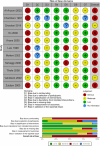Full-thickness skin graft versus split-thickness skin graft for fasciocutaneous radial forearm free flap donor site closure: a systematic review and meta-analysis
- PMID: 40426263
- PMCID: PMC12108030
- DOI: 10.1186/s13643-025-02863-7
Full-thickness skin graft versus split-thickness skin graft for fasciocutaneous radial forearm free flap donor site closure: a systematic review and meta-analysis
Abstract
Background: The radial forearm free flap (RFFF) is widely used in microvascular reconstructions. However, donor site morbidity remains a concern, with complications such as wound healing issues, functional impairments, and aesthetic concerns. While both full-thickness skin grafts (FTSG) and split-thickness skin grafts (STSG) are commonly used for donor site closure, there is insufficient evidence to determine which technique leads to fewer complications. This study aims to systematically compare FTSG and STSG in RFFF donor site closure.
Methods: We searched six databases and four clinical trial registries up to 1 March 2025. We focused on studies comparing FTSG and STSG. Primary outcome was the incidence of wound complications. Secondary outcomes included functional and aesthetic impairment. Risk of bias was assessed using the Risk Of Bias In Non-Randomized Studies-of Interventions (ROBINS-I) and quality of the evidence using the Grading of Recommendations Assessment, Development and Evaluation (GRADE) approach.
Results: Fifteen studies were analyzed, involving 933 donor site closures. No RCTs met our inclusion criteria. Meta-analysis comparing FTSG versus STSG revealed no significant differences in major wound complications (RR 0.43; 95% CI 0.11 to 1.70; p = 0.23) and minor wound healing complications (RR 0.83; 95% CI 0.60 to 1.13; p = 0.23), with the evidence graded as low to very low certainty.
Conclusion: Current evidence does not conclusively favor either FTSG or STSG for radial forearm free flap donor site closure regarding wound, functional, or aesthetic outcomes. Future well-designed RCTs are needed to provide higher-quality evidence to guide clinical decision-making. Until more robust evidence becomes available, the optimal skin graft choice should be guided by patient-specific factors, surgical considerations, and donor site characteristics.
Systematic review registration: PROSPERO CRD42023351903.
Keywords: Donor site closure; Donor site morbidity; Full-thickness skin graft; Radial forearm free flap; Split-thickness skin graft.
© 2025. The Author(s).
Conflict of interest statement
Declarations. Ethics approval and consent to participate: No statement of the institutional review board is required to perform a systematic review and meta-analysis. Not applicable. Competing interests: The authors declare that they have no competing interests.
Figures






References
-
- Yang GF, Chen PJ, Gao YZ, Liu XY, Li J, Jiang SX, He SP. Forearm free skin flap transplantation: a report of 56 cases. 1981. Bri J Plastic Surg. 1997;50:162–5. 10.1016/s0007-1226(97)91363-1. - PubMed
-
- Soutar DS, Scheker LR, Tanner NS, McGregor IA. The radial forearm flap: a versatile method for intra-oral reconstruction. Br J Plast Surg. 1983;36:1–8. 10.1016/0007-1226(83)90002-4. - PubMed
-
- Swanson E, Boyd JB, Manktelow RT. The radial forearm flap: reconstructive applications and donor-site defects in 35 consecutive patients. Plast Reconstr Surg. 1990;85:258–66. - PubMed
-
- Wolff K-D, Hölzle F. Raising of microvascular flaps. Cham: Springer International Publishing; 2018.
Publication types
MeSH terms
LinkOut - more resources
Full Text Sources
Medical
Miscellaneous

